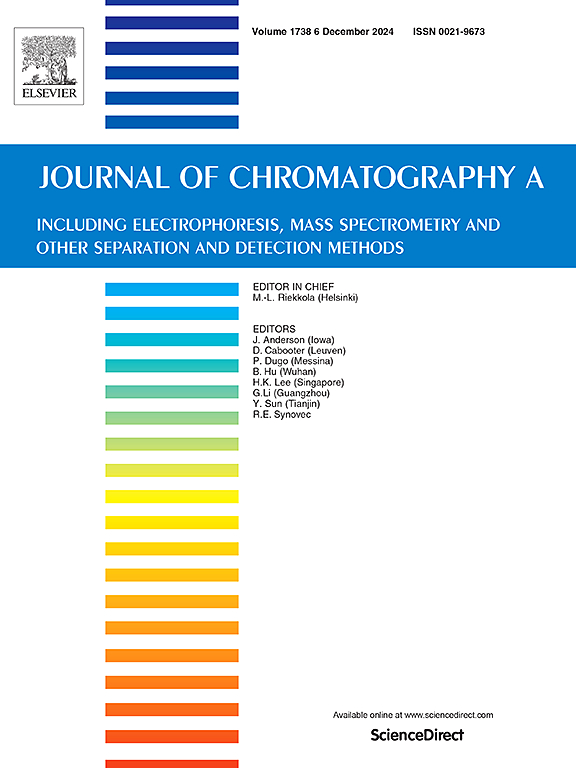从 HEK293 和 vero 细胞裂解物中亲和性纯化腺病毒的多肽配体。
IF 3.8
2区 化学
Q1 BIOCHEMICAL RESEARCH METHODS
引用次数: 0
摘要
腺病毒(AdVs)具有高转导活性和固有的免疫原性,是疫苗和溶瘤应用中的首选病毒载体。几十年来,AdV 的分离一直依赖于超速离心法和离子交换色谱法,但这两种方法都不适合大规模生产,而且很难达到足够的纯度。最近推出的免疫亲和层析树脂具有很高的结合能力和选择性,但洗脱条件苛刻(pH 3.0),产率低(< 20%),可重复使用性有限。为了寻找一种更高效、更经济的替代品,本研究首次引入了用于 AdV 纯化的多肽亲和配体。这些多肽是通过组合选择和硅学设计确定的,以腺病毒囊膜中最丰富的蛋白质--六聚体为目标。选定的多肽配体 AEFFIWNA 和 TNDGPDYSSPLTGSG 与色谱树脂连接,用于从 HEK293 和 Vero 细胞裂解液中纯化 AdV 血清型 5。肽功能化树脂具有高结合能力(停留时间为 2 分钟时,每毫升> 1010 个活性病毒)、高产率(> 50%)以及宿主细胞蛋白质和 DNA 减少多达 100 倍的特点。值得注意的是,肽配体的洗脱条件(pH 值为 8)比较温和,可以防止彭顿蛋白和纤维蛋白 "脱落",从而获得具有高细胞传导活性的完整腺病毒颗粒。通过表面等离子体共振、分子对接和动力学模拟对肽配体进行的研究证实了六聚体蛋白的选择性靶向性,并阐明了结合和释放的分子水平机制。总之,这些结果表明,本文介绍的多肽配体在从细胞裂解液中亲和性纯化 AdVs 方面大有可为。本文章由计算机程序翻译,如有差异,请以英文原文为准。
Peptide ligands for the affinity purification of adenovirus from HEK293 and vero cell lysates
Adenovirus (AdVs) is the viral vector of choice in vaccines and oncolytic applications owing to its high transduction activity and inherent immunogenicity. For decades, AdV isolation has relied on ultracentrifugation and ion-exchange chromatography, which are not suitable to large-scale production and struggle to deliver sufficient purity. Immunoaffinity chromatography resins of recent introduction feature high binding capacity and selectivity, but mandate harsh elution conditions (pH 3.0), afford low yield (< 20%), and provide limited reusability. Seeking a more efficient and affordable alternative, this study introduces the first peptide affinity ligands for AdV purification. The peptides were identified via combinatorial selection and in silico design to target hexons, the most abundant proteins in the adenoviral capsid. Selected peptide ligands AEFFIWNA and TNDGPDYSSPLTGSG were conjugated on chromatographic resins and utilized to purify AdV serotype 5 from HEK293 and Vero cell lysates. The peptide-functionalized resins feature high binding capacity (> 1010 active virions per mL at the residence time of 2 min), provide high yield (> 50%) and up to 100-fold reduction of host cell proteins and DNA. Notably, the peptide ligands enable gentle elution conditions (pH 8) that prevent the “shedding” of penton and fiber proteins, thus affording intact adenovirus particles with high cell-transduction activity. The study of the peptide ligands by surface plasmon resonance and molecular docking and dynamics simulations confirmed the selective targeting of hexon proteins and elucidated the molecular-level mechanisms underlying binding and release. Collectively, these results demonstrate the strong promise of peptide ligands presented herein for the affinity purification of AdVs from cell lysates.
求助全文
通过发布文献求助,成功后即可免费获取论文全文。
去求助
来源期刊

Journal of Chromatography A
化学-分析化学
CiteScore
7.90
自引率
14.60%
发文量
742
审稿时长
45 days
期刊介绍:
The Journal of Chromatography A provides a forum for the publication of original research and critical reviews on all aspects of fundamental and applied separation science. The scope of the journal includes chromatography and related techniques, electromigration techniques (e.g. electrophoresis, electrochromatography), hyphenated and other multi-dimensional techniques, sample preparation, and detection methods such as mass spectrometry. Contributions consist mainly of research papers dealing with the theory of separation methods, instrumental developments and analytical and preparative applications of general interest.
 求助内容:
求助内容: 应助结果提醒方式:
应助结果提醒方式:


